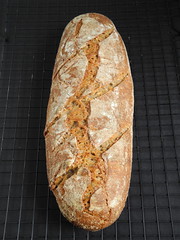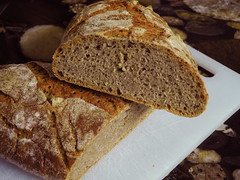 And I'm up to date on the bread blogging--I baked this bread this weekend. The seven weeks between baking the NY Deli Rye and this one allowed for recovery from Too Much Bread and Too Much Sourdough Baking (I love sourdough, but it does create more hassles in the bread-baking process), and for ordering white rye and pumpernickel flours from King Arthur to use for BBA challenge breads coming up. Other baking occurred (to be blogged later) and there were two business trips to Denver in there, too, for other distractions. Now the weather has gotten cooler, I've got a gap in my work and personal travel, and bread baking has picked up.
And I'm up to date on the bread blogging--I baked this bread this weekend. The seven weeks between baking the NY Deli Rye and this one allowed for recovery from Too Much Bread and Too Much Sourdough Baking (I love sourdough, but it does create more hassles in the bread-baking process), and for ordering white rye and pumpernickel flours from King Arthur to use for BBA challenge breads coming up. Other baking occurred (to be blogged later) and there were two business trips to Denver in there, too, for other distractions. Now the weather has gotten cooler, I've got a gap in my work and personal travel, and bread baking has picked up. I refreshed my rye starter early in the week, then made the firm starter for my usual half recipe of bread on Friday morning. It took 5-6 hours to double, then I moved it into the fridge for an overnight stay. Friday evening I mixed up the soaker of pumpernickel flour and water, and left that out overnight.
Saturday morning started the real bread making. The firm starter came out of the fridge and warmed up, then I mixed in the soaker and the rest of the ingredients, including fennel seeds as a switch from the usual caraway. I was trying to mix and knead it in the KitchenAid, but sort of messed that up--I didn't add much of the water at first, had the dough go to a pretty firm ball on the dough hook instead of Reinhart's "very tacky ball", then tried to add more water. That never works well (much easier to add more flour than more water after the dough has started to come together), so I ended up mixing more than I wanted then having to hand-knead anyway. In the end I didn't have as hydrated a dough as I wanted.
It rose well, doubling in 4 hours. I then made my second error in the shaping--while trying to form a batard without degassing the dough, I didn't get a good skin on the dough. When it rose, the loaf had lots of open holes against the covering plastic wrap. I decided to try to fix this and turned over the mostly risen loaf, brushed off as much of the flour-and-semolina dusting as I could, then let it rise a while longer. That got a better surface on my loaf (though it did crack and open up a little in that last rise), but I lost some height on the final bread in the process. Baking went smoothly using the hearth baking setup, and the somewhat flat loaf was browned and at 200°+ degrees in 20 minutes.
 The crumb was denser than I'd hoped given how well the dough rose initially, but it had a nice flavor with the fennel seeds and the rye flour. We ate most of the loaf with the now standard herbs-and-oil dip purported to be the blend used by Carrabba's Restaurants, despite competition from a whole-wheat-and-dried-cherry challah still warm from the oven. I do have to attribute part of the gobbling of the rye bread to the herbs and oil, and another part to older niece breaking her Yom Kippur fast in serious carb-loading mode. I think the bread goes in the "good, but won't try it again" pile.
The crumb was denser than I'd hoped given how well the dough rose initially, but it had a nice flavor with the fennel seeds and the rye flour. We ate most of the loaf with the now standard herbs-and-oil dip purported to be the blend used by Carrabba's Restaurants, despite competition from a whole-wheat-and-dried-cherry challah still warm from the oven. I do have to attribute part of the gobbling of the rye bread to the herbs and oil, and another part to older niece breaking her Yom Kippur fast in serious carb-loading mode. I think the bread goes in the "good, but won't try it again" pile.
No comments:
Post a Comment